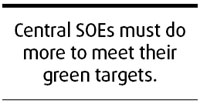SOEs' green goals
(China Daily)
Updated: 2008-04-17 07:22
Updated: 2008-04-17 07:22
Centrally-administrated State-owned enterprises (SOEs) should serve as the backbone of the Chinese economy not only by earning profits but also by playing a leading role in fulfilling the country's green goals.
However, compared with their robust profit growth in recent years, the targets the State-owned Assets Supervision and Administration Commission (SASAC) set for central SOEs on energy conservation and pollution control looked rather modest.

Thanks to the deepening of market-oriented reforms, the number of central SOEs has gradually declined from 196 in 2002 to 150-odd last year, while their aggregate profits soared by more than 30 percent annually, much faster than the growth of the national economy.
Yet, in a recent online interview, a senior official from SASAC revealed that key SOEs will strive to cut energy consumption by 20 percent and major pollutants by 10 percent per unit of GDP by the end of 2009, just one year ahead of the national deadline.
It is certainly reasonable to argue that the higher base level for central SOEs makes it more difficult to further raise energy efficiency and lower pollutant emission than many other domestic enterprises. The huge size and advanced technology that key SOEs enjoy have already enabled most of them to produce in a much more energy-efficient and cleaner way.
But as big producers and consumers of energy and resources, central enterprises have more than a duty to meet the national green goals by themselves. That alone will not be enough to ensure the achievement of China's five-year green goals between 2006 and 2010, which is only the initial step to change the country's growth pattern toward an energy-saving, environment-friendly and sustainable one.
Central SOEs must play an exemplary role in the country's drive to go green. It is not just their social responsibility to meet the green goals. In fact, saving of energy and reduction in pollutant emission can help them save costs and make more profits.
A major problem that prevents many enterprises from going green is their lack of funds and technologies.
Central enterprises are financially and technologically better equipped than most domestic enterprises to do so. If they can invest more to pursue higher energy efficiency and manage to profit more from it, numerous small and medium-sized enterprises may be encouraged to follow suit.
But if key SOEs are only told to target just-above-the-average energy and environmental goals, it is hardly possible for other domestic firms to do more in this regard.
(China Daily 04/17/2008 page8)
|
|
|
|